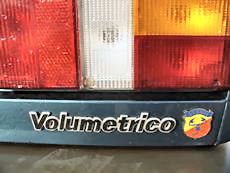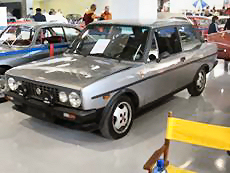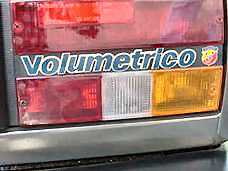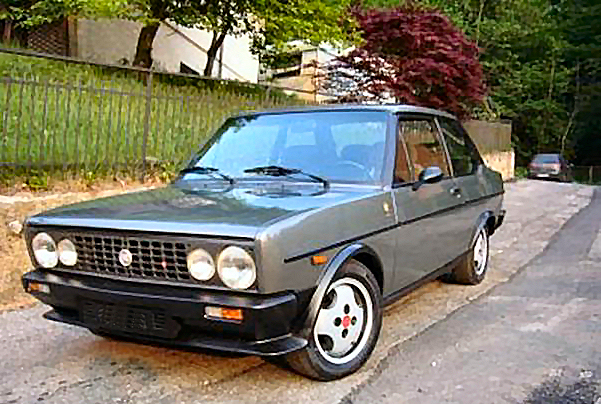The
131 Supermirafiori Volumetrico and the 131 Racing Volumetrico.


A significant part of the history of the Fiat 131
is represented by the Abarth Volumetrico versions based on the
second series Racing version and third series Supermirafiori
version. This is the story of Fiat’s experimentation with
super-charging and its application to the road going versions of the
Fiat 131.
Introduction:
Supercharging was, in the period between the two
world wars, very popular on race and sports cars as a means of
boosting engine power without resorting to larger capacity engines.
Until the 1950’s it was quite common to supercharge such cars. There
are several online sources which provide much detail about the
history and basic workings of this system.
A basic explanation of Super charging and Turbo
charging.
Supercharging:
An air pump compresses the intake air together
with petrol. As a result more mixture is available in the combustion
chambers. The energy which is generated as a result of the explosion
of this mixture is greater, resulting is more power being delivered
to the crankshaft. The supercharger is driven through a toothed belt
by the crankshaft of the engine. This means that the supercharger
is running together with the engine all of the time. That does drain
some power but the net effect is positive. The biggest advantage
from a supercharger over a turbo compressor is that the extra power
is immediately available at any engine speed!
Turbo charging:
The turbo compressor has an axle with two finned
wheels, one of which is connected to the exhaust, the other one to
the air intake. Exhaust gasses make the finned wheel run very fast
(in some cases over 200.000 rev/min) Because the wheel at the intake
side also runs the same speed, air is compressed which brings more
mixture into the combustion chamber.
In comparison with the super charger the
turbocharger solution does not drain power to keep the process going
because it is driven by the exhaust gasses alone.
The main disadvantage of the turbo solution
compared with super charging is that the turbo requires a certain
revolution speed from the engine to generate its power. The time
taken to reach this engine speed (and therefore generate the
additional power) is known as turbo lag. The turbo lag on the BMW
2002 Turbo, for instance is notorious. Initially no additional
thrust is provided before the extra power is delivered with a rush.
Exciting, but not always what is needed in an emergency or even
normal driving!.
It is interesting to see that Volkswagen is
especially busy at the moment with engines fitted with both a
supercharger and a turbo compressor to use the best qualities of
both systems
Fiat and supercharging:
By mid 1975 the research and development
department of Abarth initiated their own supercharger project. The
then current Abarth president Aurelio Lampredi , who also designed
the famous Fiat twin cam engine that is respected so much, employed
a specialist to do the major blower development, testing and
building. Developing this engine was his last job as an active
engineer.
In 1980 the first cars were available for
testing. Italian car magazines of that period show Fiat 131 Racings
fitted with supercharged engines. Abarth tested the superchargers on
the twin cam engines with 1301 and 1995cc capacity, probably also on
the 1585cc version.

Officially in May 1981, 2 months after the launch
of the 3rd Series Mirafiori the 131 Supermirafiori
Volumetrico was introduced to the Italian market. The Racing
Volumetrico was also available to order by then.
The Lancia 037 used the same type of engine with
supercharger and was actually built at the same address. The
development all took place at Abarth Corse, which was changed a
little later into Lancia Corse. Very soon after Fiat stopped
marketing the 131 Volumetrico’s, Lancia adopted the technology and
introduced it to a range of existing models including the Beta
Coupe, HPE Trevi and very limited the Montecarlo(Scorpion).These
supercharged models carried the suffix Vx. The superchargers fitted
on the Lancia Beta were around one third smaller compared with the
examples used on the Fiat 131 and Lancia 037 versions. The Fiat 124
Spidereuropa Volumex and Argenta VX also had the smaller “Lancia”
unit fitted. Generally people in the business name the cars fitted
with the bigger units Volumetrico and the smaller ones Volumex. This
is the reason that the volumetrico word is used in this story
instead of Volumex or VX. In 1984 Lancia also ceased production of
their Volumex versions. The last supercharged Fiat group vehicle,
the Fiat Argenta Vx, was marketed until 1985.


With Fiat and Lancia as the exceptions, in that
period there was not a single marque which offered a supercharger
in a production car. Interesting to note is that Lancia used both a
supercharger and a turbo compressor on the Delta S4. It took years
before the industry realised how worthwhile the use of a
supercharger could be and we can now see at last that Mercedes,
Jaguar, Volkswagen and Aston Martin are using superchargers in their
production cars. The story continues…..
The Fiat 131 Supermirafiori Volumetrico Abarth


Based on the third series Fiat 131
Supermirafiori , which was introduced in March 1981, the Volumetrico
version followed in May 1981, exclusively for the Italian market
and was available for less than 1 year. All the cars were produced
in silver grey metallic. Air conditioning was not available as the
cooling equipment was mounted in the same location as the
supercharger equipment. The car had a list price of L. 13.590.000
which was a premium of L 3.660.000 (27%) over the price of the
normal Supermirafiori 2000.
These Volumetrico versions were all numbered
inside the left louvre of the bonnet with red numerals. The series
should have been around 200 units and number 188 is the highest
number known to the author at the time of writing.
The engine code for these cars was Fiat 131 A2 V2
and the engine has type number 232 R 10. The 232R10 coded engines
produce 140 DIN HP at 5500 revs and have a maximum torque of 21,8
mkg at 3000 revs.
Petrol consumption per 100 km : * at 90 km/u 8
litres
At 120
km/u 10.5 litres
At city
traffic 11.5 litres


The most important mechanical and cosmetic
differences between the standard Supermirafiori 2000 and the
Volumetrico were:
-
Engine with
lower compression ( 7,6:1 instead of 9:1) and other pistons,
valve seats and exhaust valves, crankshaft etc. Including the
supercharger the engine weight is 40 kilograms extra over the
standard model.
-
10:39 rear axle
instead of 12:43 to have faster acceleration.
-
Heavier duty
clutch
-
Different air
filter and air filter housing
-
Different oil
filter mounting and oil filter ( the normal one also fits!)
-
Different
exhaust with chrome oval tail pipe
-
Larger
ventilated front brake discs
-
Heavier duty
suspension and stronger shock-absorbers
-
Torsion bar
with bigger diameter
-
Oil cooler
fitted
-
Electric petrol
pump fitted near the petrol tank
-
Green
instrument markings
-
Three
additional gauges fitted in the location of the radio also with
green markings. From left to right, they provided information on
oil pressure, super charger pressure and oil temperature.
-
Pirelli alloy
wheels with Pirelli P6 185/60 HR 14 tyres
-
Volumetrico
sign with plastic Abarth shield on the rear panel where normally
the Supermirafiori emblem is fitted.(4)
-
Volumetrico
sign with metal Abarth shield on the left front wing.




The Fiat 131 Racing Volumetrico Abarth.
At the same time as the Supermirafiori
Volumetrico became available, the Racing Volumetrico version was
also on offer. The history of this car is more difficult to
establish.


Fiat built the last 131 Racings in January 1981
as they were based on the second series Mirafiori. Then they
retooled the factory for production of the Supermirafiori 3rd
series. A large number of unsold Racings went to the Abarth factory
and waited there (Italian sources speak of over 200 cars). This is
interesting and important in its history as the Racing Volumetrico
actually came on the market after the production of that model
stopped!
Where body colour is concerned it should be
explained that of the 4 factory colours that Racings were produced
in, orange was already out of production and black was only on offer
for export markets. As a result it is understood that almost all
Racing Volumetrico’s were either silver or gun metal grey.
It was possible to order a 131 Racing OR a 131
Racing Volumetrico until the stocks were sold. There should have
been an official production run of 25 numbered silver grey Racing
Volumetrico’s. The author thinks that these cars were built before
the end of production and were also used for testing. The last
produced Racings which came to Abarth unsold in early 1981 did not
belong to that run of 25 cars. It is known that the last cars did
not sell well and that Abarth gave their workers a 50% discount on
the total price from 1983 till 1984. The last sold car was
registered not earlier than May 1984.
It is not known how many cars from this last
stock of 200 or so cars were sold either as a normal Racing or
Racing Volumetrico therefore it is unclear what is the total
production figure. That many more were produced than the officially
recorded number (25) is clear, at least as indicated by the number
of cars that regularly appear for sale.
The modifications to a standard car to produce a
131 Racing Volumetrico are exactly the same as those carried out to
the Supermirafiori Volumetrico. The Racing Volumetrico bore the
engine code AK V1.


Driving Impressions:
Driving a 131 Volumetrico after a normal Racing
or Supermirafiori gives the impression that the car is much smoother
than both. There is significantly more low down power and as a
result one can drive the car with less gear changing ( read more
lazily). Actually the biggest compliment you can give the Abarth
technicians is that the drive is not that spectacular and instead
appears almost effortless. The car pulls strongly from as little as
1500 rpm until the red line. The extra power raises the top speed
above the standard car -. Abarth claims 190km/h while Fiat claims
180km/h for the standard Racing and 175km/h for the standard
Supermirafiori .The sound of the engine is similar to that of the
normal 2000 engine except that one hears the supercharger slightly.
One can also hear the electric fuel pump in the back of the car.
That fuel pump aids easy starting, no matter if the engine is hot or
cold. The road holding of the Volumetrico is very firm and the car
feels more strongly built than the normal Racing and Supermirafiori.
Braking is also stronger thanks to the larger and ventilated front
discs although the braking performance is not the best performance
element of the Mirafiori range.


Desirability
The interest in this type of car is growing
because of the interesting engineering solutions and the relatively
few numbers produced. In addition these cars were made at Abarth and
that gives them a very special place in Italian car history
Market values
It is not easy to state anything definitive about
the market value because there was only a very limited production
run and there are only a few cars on the market every now and then.
As a general guide expect to pay between 5000 and 9000 euro for a
good car. There is actually not a big difference in value between
the Supermirafiori Volumetrico and Racing Volumetrico..For less
money you buy mostly a project car. Larger amounts are asked for the
very best cars or examples with a specific history. The author
expects that prices will get higher in the future as people begin to
realise that these cars qualify as being the last “real” Abarths!


Interesting facts:
(1)
There are two examples of the Supermirafiori Volumetrico known to
the author which are fitted with air conditioning. They bear
production numbers 96 and 158. The air conditioning is mounted in a
completely different location from normal. Pictures available on
request.
(2)
Several Racing Volumetrico’s were spotted with the additional gauges
fitted in the center console.


(3)
Wheels fitted:
Supermirafiori Volumetrico ET38( as the Ritmo 125
TC)
Racing Volumetrico ET 25
For completeness, the Ritmo/Strada 130 TC had the
same design wheels with ET60.
(4) Several cars have been spotted with emblems
on both wings, one could order the emblems separately. The Racing Volumetrico had the Volumetrico emblem in the right tail light. The
author has seen cars with a small Abarth shield immediately behind
and also with the bigger shield on the metal stripe under the
taillight (same location as the Supermirafiori Volumetrico).


(5)
The author and his Italian source never saw a numbered Racing
Volumetrico but heard the story regarding possible production
numbers from a mechanic who worked for Abarth in the early eighties.
(6)
Both the author and his sources expect a production figure of around
100 Racing Volumetrico’s but it could be less or even more.
Sources and acknowledgements:
1 Ruoteclassiche no 36
2 Quattroruote no 296
3 Quattroruote no 309
4 Abarth factory brochures and pricelist
5 Autovisie no22 1982
6 Several 1:1 cars
A big thank you goes to Mauro Balcet from Italy
as he was extremely helpful with giving information about the cars
for creating this article.
The author is always interested in more
information about these specialist cars which may unravel the myth a
little bit more. It took years of investigation to arrive at this
stage of the story.
Additional information appears on the forum
section of www.131mirafiori.com
Albert Brouwer
Dronten,June 2008


